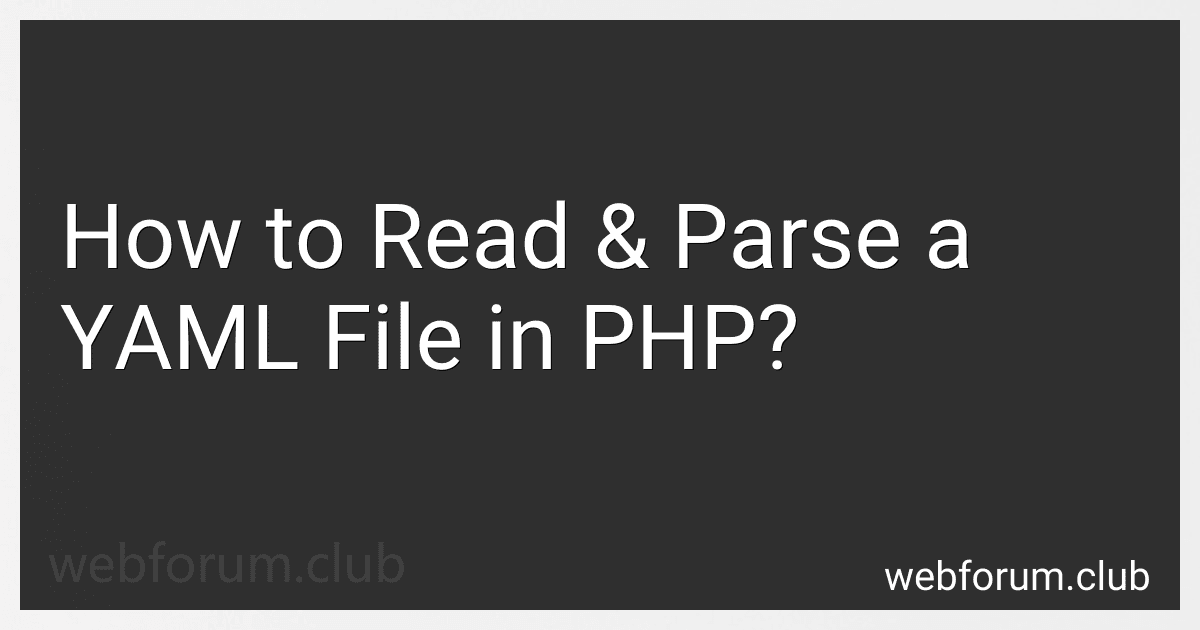Sure! YAML, which stands for "YAML Ain't Markup Language," is a human-readable data serialization format. It is commonly used for configuration files and data exchange between programming languages. YAML files use indentation and simple syntax to represent data structures like lists, dictionaries, and scalars.
In PHP, there are libraries and extensions available for handling YAML files. The most popular one is the "Symfony YAML Component," which provides convenient methods for parsing and dumping YAML content.
To work with YAML in PHP, you need to install the Symfony YAML Component using Composer, a dependency manager for PHP. Once installed, you can use it in your code by including the Composer autoloader, and then import the YAML class:
require_once 'vendor/autoload.php';
use Symfony\Component\Yaml\Yaml;
You can then use the YAML class to parse a YAML file or string into PHP data structures:
$data = Yaml::parseFile('config.yaml');
Or, you can directly parse a YAML string:
$yamlString = " name: John Doe age: 30 "; $data = Yaml::parse($yamlString);
Similarly, you can convert PHP arrays or objects into YAML format using the dump() method:
$array = ['name' => 'John Doe', 'age' => 30]; $yaml = Yaml::dump($array);
The resulting YAML content can be saved to a file or used as needed.
Remember that YAML is sensitive to spacing and indentation, so it's essential to maintain the correct structure and formatting in your YAML files for proper parsing.
That's a brief overview of YAML and its usage in PHP. It provides a simple and readable way to handle structured data in your applications.
What is YAML file in PHP?
YAML (YAML Ain't Markup Language) is a human-readable data serialization format. In PHP, a YAML file is a file that contains data structured in the YAML format. It is commonly used for configuration files, data exchange between systems, or storing data that needs to be easily readable and editable by humans.
In PHP, there are various libraries and extensions available that provide functionalities to read and write YAML files. These libraries allow developers to parse and manipulate the data in YAML files easily. They provide methods to convert YAML data into PHP arrays or objects and vice versa.
YAML files can be used in PHP to store and retrieve configuration settings, define data structures, or represent complex data in a readable format. The simplicity and readability of YAML make it a popular choice for storing and exchanging data in PHP applications.
How to Read a YAML File in PHP?
To read a YAML file in PHP, you can use the Symfony YAML component. Here's a step-by-step guide:
- Install Symfony YAML component using Composer by running the following command in your terminal:
composer require symfony/yaml
- Require the autoload file at the top of your PHP script to load the Symfony YAML component:
require_once 'vendor/autoload.php';
- Use the parseFile() method from the Symfony YAML component to read the YAML file and parse its contents into a PHP array. Here's an example:
use Symfony\Component\Yaml\Yaml;
$file = 'path/to/yourfile.yaml'; $data = Yaml::parseFile($file);
Make sure to replace 'path/to/yourfile.yaml' with the actual path to your YAML file.
- You can now access the data from the YAML file using the $data variable, which contains an associative array representation of the file contents. For example, if your YAML file has a key named name, you can retrieve its value like this:
$name = $data['name'];
That's it! You've successfully read a YAML file in PHP using the Symfony YAML component.
How do I Parse a YAML File in PHP?
To parse a YAML file in PHP, you can use the Symfony YAML component. Here are the steps to do so:
- Install the Symfony YAML component using Composer by running the following command in your project directory:
composer require symfony/yaml
- Create a new PHP file and include the Composer autoload file at the top:
require 'vendor/autoload.php';
- Use the Symfony\Component\Yaml\Yaml class to parse the YAML file:
use Symfony\Component\Yaml\Yaml;
// Specify the path to your YAML file $yamlFile = 'path/to/your/file.yaml';
// Parse the YAML file $data = Yaml::parseFile($yamlFile);
- You can now access the parsed YAML data as an associative array. For example, if your YAML file has the following structure:
fruit:
- apple
- banana
- orange
You can access the fruit array in PHP as:
$fruits = $data['fruit']; // Array containing ['apple', 'banana', 'orange']
That's it! You have successfully parsed a YAML file using PHP and the Symfony YAML component.
